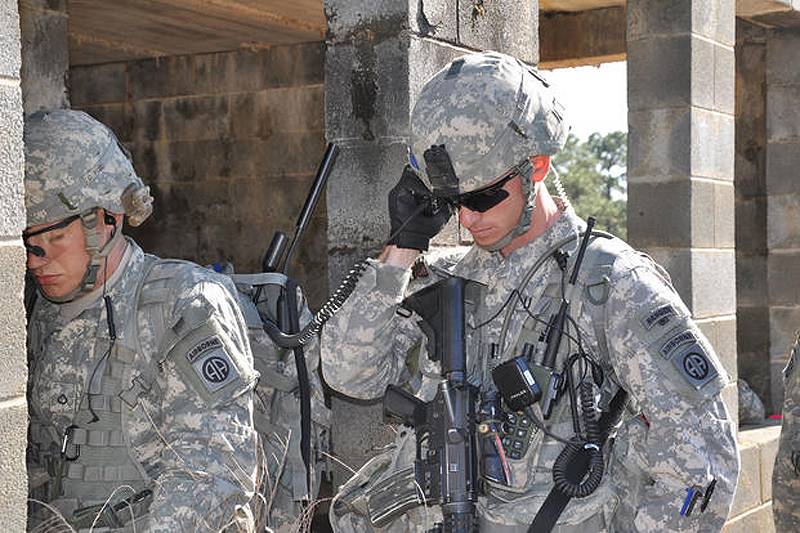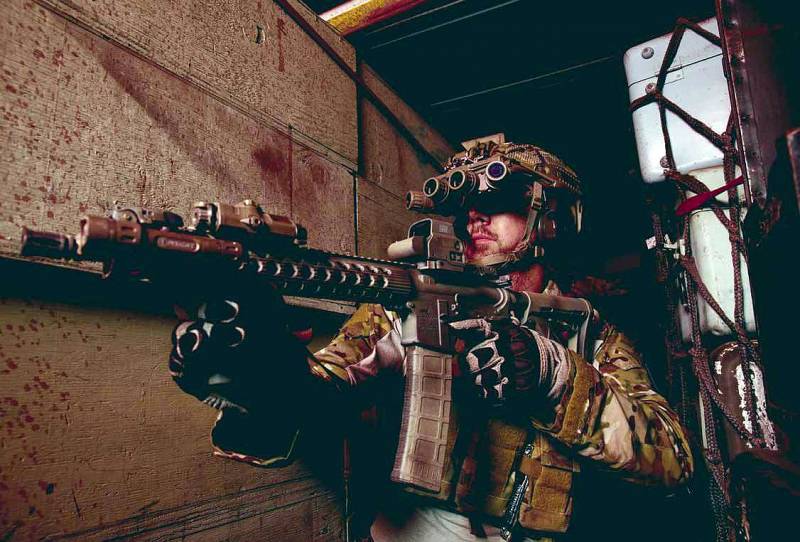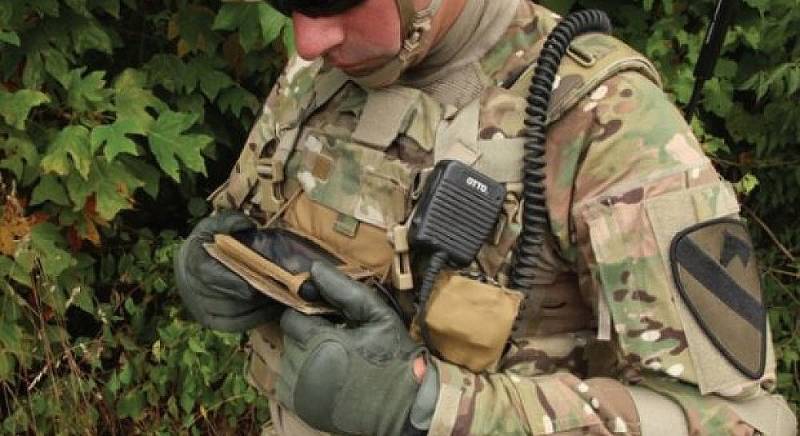The new systems will help the soldier to increase the level of possession of the situation
The limited field of view of standard night vision goggles forces the soldier to rotate his head continuously in an attempt to scan the area in front of him. L-3’s Panoramic NVG more than triples the review area
The term “fog of war” is often used to describe the uncertainty that historically surrounds much of what happens on the battlefield. Despite advances in sensors, communications, information processing, and data distribution, there are still information gaps that may be critical. This becomes especially evident at the level of an individual soldier and a small unit. Incomplete, untimely and inaccurate information about the environment can cause the death of both an individual soldier and members of a battle group. However, previously a lot of attention was paid to increasing the level of command of the combat situation of the highest command echelons. The soldier basically had to rely on his own abilities. The situation began to change partially due to the progress in data processing, subsystem layout and their miniaturization, which allowed us to obtain new possibilities in designing and manufacturing sufficiently small, robust and simple devices that could be carried and used by soldiers in the field. All this is inherent, for example, modern mobile phones, which have become an integral part of our lives.
Whether it is a shooter or a member of the crew of an armored combat vehicle, each soldier wants to know a few basic data: his exact location (and the location of his colleagues), information about the surrounding terrain and landmarks and where the enemy is located. Ideally, this information should be transmitted day and night, in any weather, regardless of vegetation and geographical features of the area. In addition, the ability to communicate and exchange observation data with members of his group and higher command improves the maneuverability of the unit and the effectiveness of its fire.
Achieving such opportunities was the goal of a number of military initiatives in many countries. “Increasing the level of control of the situation on the battlefield of an individual soldier and a small unit is a rather difficult task, but it also provides significant potential advantages and benefits in combat situations,” said one of the officers of the American Army.
All these tasks the American army tried to solve in its program Mounted Land Warrior. In 2006, the Stryker Brigade team was equipped with the Warrior Stryker Interoperable system developed by General Dynamics to conduct operational assessments in training scenarios. As Neil Evrinham of the Doctrine Development and Combat Training Command (TRADOC) explained, “The system unites Stryker combat vehicles, combat groups and soldiers, thereby ensuring unprecedented exchange of real-time information within the units and their personnel.” After a year of evaluation tests, the system was sent to Iraq, where it was successfully involved in combat operations. Her ability to link a soldier and an infantry unit with a larger tactical picture was evaluated as a factor in increasing combat capabilities. The system was able to offer a clearer, unified picture based on complete and reliable information collected in real time, which allowed the various elements in the unit to respond more effectively with their fire weapons and maneuver. The military were unanimous in that the system, even at such an early stage, significantly increased tactical awareness and contributed to increased combat effectiveness.
Situational awareness on the battlefield
“Possession of the situation on the battlefield for a soldier is the ability to know your position relative to other members of the unit, the location of a potential enemy and the terrain features,” explained the TRADOC representative.
Historically, the military relied mainly on visual observation, and therefore much attention was paid to the development of systems that improve the soldier’s natural sense organs, in particular vision. This includes zoom optics for better target acquisition and aiming, plus night vision devices and other tools that are effective in reduced visibility. Both image enhancement systems, such as night vision devices (NVD), and thermal sights are individual systems. A BAE Electronic Systems representative believes that “night vision offers tremendous advantages, allowing you to operate even in conditions of limited visibility. It expands the capabilities of the human eye, for example, the imager detects temperature differences and thus can see through vegetation or smoke and identify hotter objects against a colder background. However, although night vision well detects objects, it has the worst ability to identify objects within sight. It can be difficult to distinguish your soldier or car from a soldier and an enemy vehicle. ” The high probability of fire has always been a problem at night and in conditions of limited visibility, while, despite the use of night vision devices, it has not lost its sharpness.
Since its introduction in the 80-ies of the last century, the NVD technology, which has made a significant contribution to increasing the local situational awareness of an individual soldier, is now more closely integrated with other technologies. An example is embedding the necessary data in a display, for example, direction, target data and warning signals.
Panoramic night-vision goggles Ground Panoramic Night Vision Goggle from L-3 Insight solves the narrow field of vision that most standard night vision devices have. The device GPNVG-18 has a field of view 97 degrees, such a wide field of view reduces the number of turns of the head, which helps to reduce operator fatigue.
The newest ENVGII / FWS-1 night-vision goggles, integrated with a gunsight, from BAE System, use wireless technology to produce a dual-purpose, helmet-mounted vision system. The company BAE said that "when integrating both blocks, the image from the sight and the aiming mark can be instantly transferred to the glasses, which gives a tactical advantage during the execution of melee tasks."

Small radio stations provide not only the transmission of voice messages. Thales SquadNet Radio includes GPS and a Bluetooth encrypted data channel. This allows you to display the position of the user and his colleagues on devices with Android OS
Location
Determining the location or coordinates of any object has always been the most important skill of a soldier, contributing to the successful implementation of the task. This meant a good knowledge of the area and an accurate correlation with the map. But there were often errors and incorrect calculations. In addition, it was the responsibility of the commander, who could only determine the position of his unit. For a small unit, ideally, you need to know in real time the location of all its soldiers, its other units and even the coordinates of the enemy positions. To do this, you must track the position of each soldier (or car) and then be able to share this information with others. The widespread availability of GPS (Global Positioning Satellite) networks and the miniaturization of GPS receivers make this information about the location of each soldier easily accessible.
GPS allows you to track your own location, movement, and when using a mapping program, tie all obtained coordinates to a location. This system is currently widely distributed and is available on a variety of devices. It allows you to significantly expand the possibilities on the battlefield. For example, the US Marines received a new Common Laser Rangefinder hand-held laser rangefinder from Elbit Systems of America as a common-use device. It includes GPS and a laser designator, which allows any user to determine the coordinates of targets with high accuracy.
However, the growing threat of potential damping of GPS signals caused an increase in interest in alternative technologies that could provide accurate coordinates if GPS signal was unavailable or degraded. These opportunities have long been available for combat vehicles in the form of inertial navigation systems, but now this solution requires a lot of energy and is too much of a burden for a dismounted soldier. WINS (Warfighter Integrated Navigation System) is a project to develop a portable device that widely uses the achievements of the miniaturization process, in particular inertial sensors. The WINS system being developed at the Communication Electronics Research Center (CERDEC) uses several sensors, tracking a soldier’s movement from the last known point and recording steps, speed, time, altitude and other factors that allow the soldier’s position on the map. Also, the Center is studying the possibility of using the so-called pseudo-satellite operating at low altitudes. It can be a balloon, a drone, or even a ground vehicle. Another promising technology is called Chip-Scale Atomic Clock or CSAC. It provides accurate time for the GPS receiver when jamming or loss of signal, allowing you to quickly retake the signal. As the combat experience of Ukraine shows, the interest in navigation / positioning is not based on GPS, but all these devices, which are under development, are still too raw.
Means of communication
For many centuries, the main means of maintaining communication between soldiers and commanders was a voice, without any means of reinforcement. Simple shouts of commands and comments could simply not be heard or misunderstood in the noise of battle or they would be inappropriate in cases where silence is necessary. The solution here should also be simple. Deploying small lightweight radio stations allows the commanders and fighters of small units to exchange voice messages and data.
Effective command transfer and tactical information distribution in the unit remains a challenge. First, effective means of its delivery and, secondly, effective means of its withdrawal. However, there are more simple ways to achieve improved situational awareness. Due to the combination of each soldier’s assessment of his environment, it is possible to create and present a broader situational picture of the unit. The emphasis is on using technology to distribute this wider picture across the entire unit.
One of the most important ways to achieve this goal is simply to maintain communication between all stakeholders. A representative from Harris Corporation noted: “Digital technologies have allowed the military to get great benefits, not only ensuring the transmission of voice messages and data necessary to maintain a level of situational awareness, but also allowing them to be connected to various means of communication. Our new radio station AN / PRC-163 uses frequency division technology, allowing the user to receive information and send up and down the command chain, as well as through a single network backbone, while connecting to computer devices, including Android smartphones. It can simultaneously transmit information through a combination of existing satellite communications, in-line VHF communications and mobile peer-to-peer networks. ” It is equally important that the devices for the soldier are simple, light and compact. PRC-163 weighs 1,13 kg and has dimensions of 15,24x7,62x5,08, see. One of the features of the radio station is that it can transmit voice messages and data simultaneously.
“Thales Communications’s SquadNet radio station, according to its spokesperson,“ includes a GPS system that allows you to transfer data in a secure mode via Bluetooth to a device with Android OS. This allows users to see not only their position, but also the location of their fellow workers. ” It also has an automatic retransmission mode, which is especially useful in the city, forest and mountainous terrain. You can use up to three hops, which increases the range from 2,5 km to 6 km. SquadNet’s own radio display allows soldiers to see their location and automatically share this information over the network with other military personnel. The issue of power supply has also been resolved, since the radio can operate on its rechargeable battery for up to 28 hours, which eliminates the need to carry a spare battery with it.
The tablet used in the program of the American Army NETT Warrior, offers useful functions for data entry and viewing graphics, but has the disadvantage that the user has to look down and distract from what is happening around
Display
Providing the soldier with the necessary information is also of great importance. In the process of finding ways to increase the soldier’s awareness and present a broader tactical picture, it is easy to overload him from a cognitive point of view and, thus, actually reduce his ability to perform basic combat missions. One of the developers of the future GladiusldZ-ES (Infanterist der Zukunft-Erweitertes System) soldier’s equipment for the German Bundeswehr from Rheinmetall noted: “The key problem in the department is maintaining the individual’s cognitive load at a reasonable level in accordance with his role in the department. Here it is necessary to focus on simple and intuitive soldier functions. ” He explained that “Gladius, firstly, at the level of the squad must provide a common operational picture for each member of the squad and higher command. Secondly, it should provide reliable voice and data exchange. The data should include goals, intermediate coordinates, maps, orders, hand-drawn sketches, images and videos. Finally, it must provide access to the picture with the location of their own and enemy forces. ” The idea is to improve the soldier’s understanding of the environment beyond the boundaries of his immediate environment, but be selective enough not to overwhelm him with details that are not directly related to current events.
Feedback on the results of the deployment of the first systems made a great contribution to their improvement, it allowed to identify many problems and shortcomings and to propose new ideas and solutions. For example, thermal imaging sights of weapons were initially created as simple optical sights, that is, a soldier had to bow his head and direct his gaze along the barrel. This limited the possibilities of general observation. The French company SAFRAN, in the framework of the FELIN soldier’s equipment for soldiers (Fantassin a Equipement et Liaisons Integres, an integrated infantry and communications equipment), has developed a system capable of capturing an image of a sight and bringing it to a monocular mounted on a helmet. The soldier is now free to move his head, observing in an extremely wide sector, at the same time, if desired, he can also see a thermal image. A spokesperson for SAFRAN said that “it also allows the arrow to observe and fire from around the corner. The FELIN equipment was put into service in 2010, after which the company developed a more advanced version. The NeoFelis outfits incorporate new technologies and take user comments into account. ”
The American Army’s Communications Research Electronics Center is developing a bright, high-resolution microdisplay of 2048x2048 pixels the size of a postage stamp. The ultimate goal is to get a practical head-on display. As the Nett Warrior System demonstrates, modern microdisplays do not provide normal reading of text and data. As a result, soldiers need to look down at a hand-held display in order to get coordinates and other data. In this case, they can easily lose control over the situation in front of them. New microdisplay, attached to the helmet, allows to solve this problem. The micro display does not only present a soldier with a clear display of what is in front, day or night, he can also display several layers, for example, maps and symbols showing the disposition of his units and enemy forces.
Based on the experience of deploying previous systems and user feedback, it was concluded that the soldier should control his weapon. This meant that the radio station, sight, and other systems needed to be mounted on the weapon itself. In this case, a good solution could be the introduction of wireless channels of the BlueTooth standard. Wireless communication has the advantage over wired communication in that cable is excluded, which can cling to branches and get tangled underfoot. The combination of such wireless solutions with the helmet-mounted display can make it even easier for the shooter to get data about the environment by viewing information without tilting the head while driving and observing from the corner.
Integrated solutions
Achieving an adequate level of situational awareness for a soldier on the front line requires an integrated approach. The British Laboratory of Defense Science and Technology implements such a solution in its DCCS system (Dismounted Close Combat Sensors - hurried melee sensors). The modular DCCS system includes GPS, inertial navigation system and tracking subsystem. The system includes a camera on a helmet, plus lasers mounted on the weapon, a new thermal sight, and built-in magnetic sensors. The commander can not only see where the soldier is, but also where his weapons are directed.
The DCCS is currently in a demonstration phase. However, the use of ready-made civil technologies in it may well serve as a model for creating promising soldier systems. This would allow keeping the cost of the systems at such a level that they can be purchased in sufficient quantity for deployment in each branch, up to the equipment of an individual soldier. Price accessibility may be the biggest obstacle to the advancement of the individual soldier’s situational awareness systems. Warlords believe that the most advanced system, even released in limited quantities, will always be with those who need it, in the right place at the right time. This is at least a dubious assumption. It may be better to adopt less advanced and sophisticated decisions - those that can be given to each individual fighter.
Materials used:
www.shephardmedia.com
www.l3t.com
elbitsystems.com
www.harris.com
www.thalesgroup.com
www.rheinmetall.com
www.safran-group.com
www.gdls.com www.defenceprocurementinternational.com
www.army-technology.com
www.wikipedia.org
en.wikipedia.org


Information